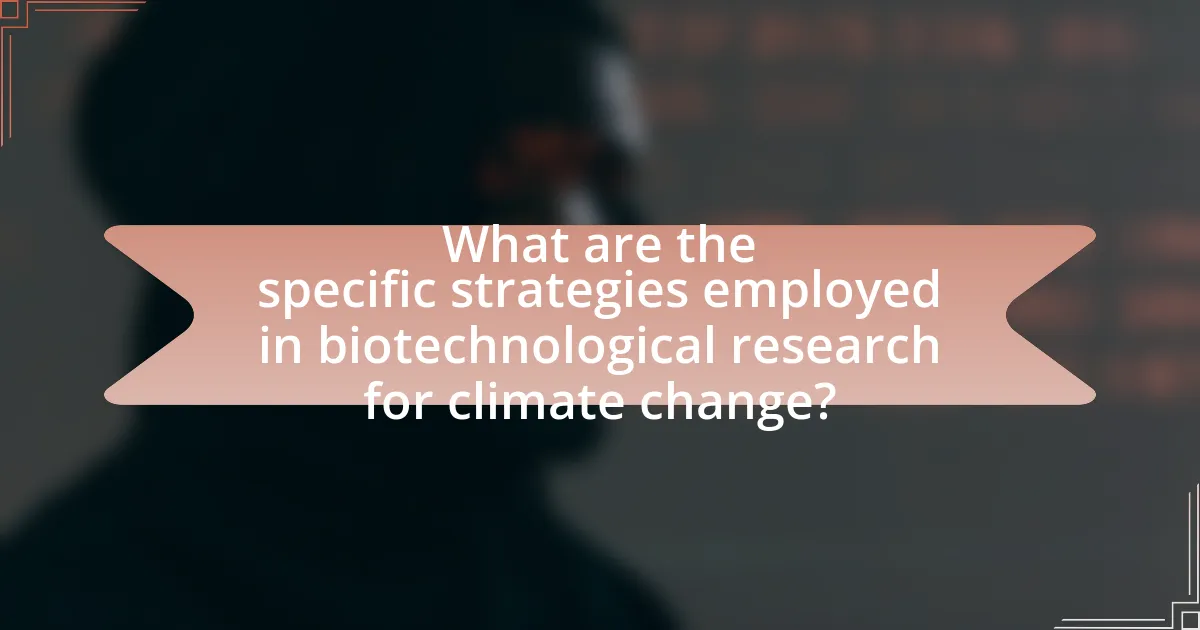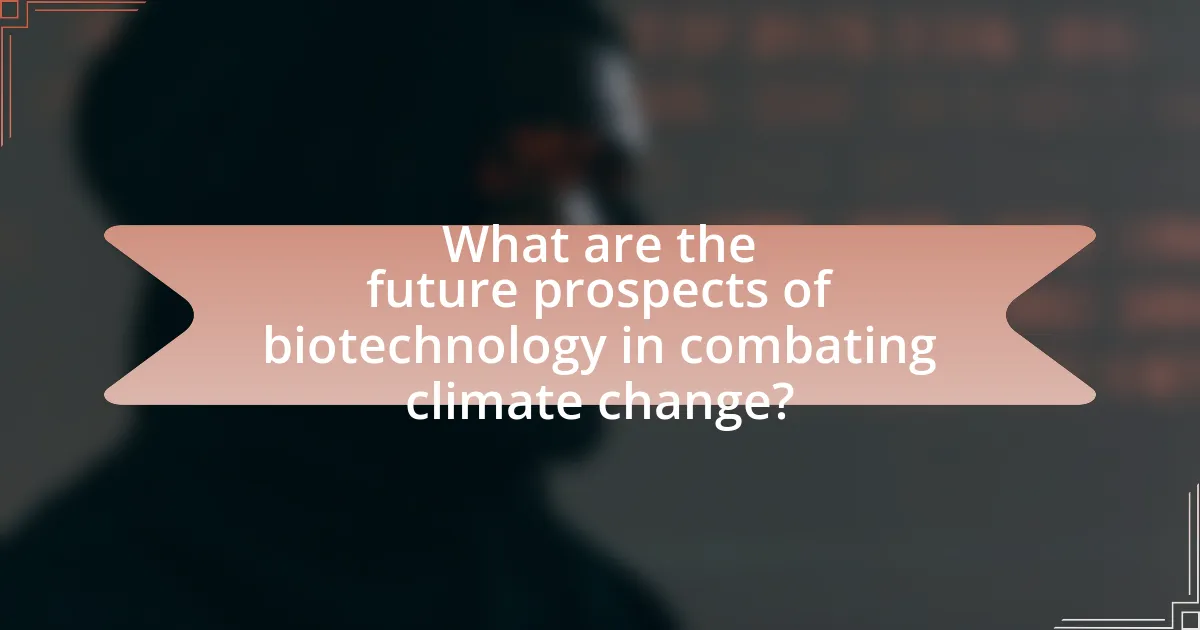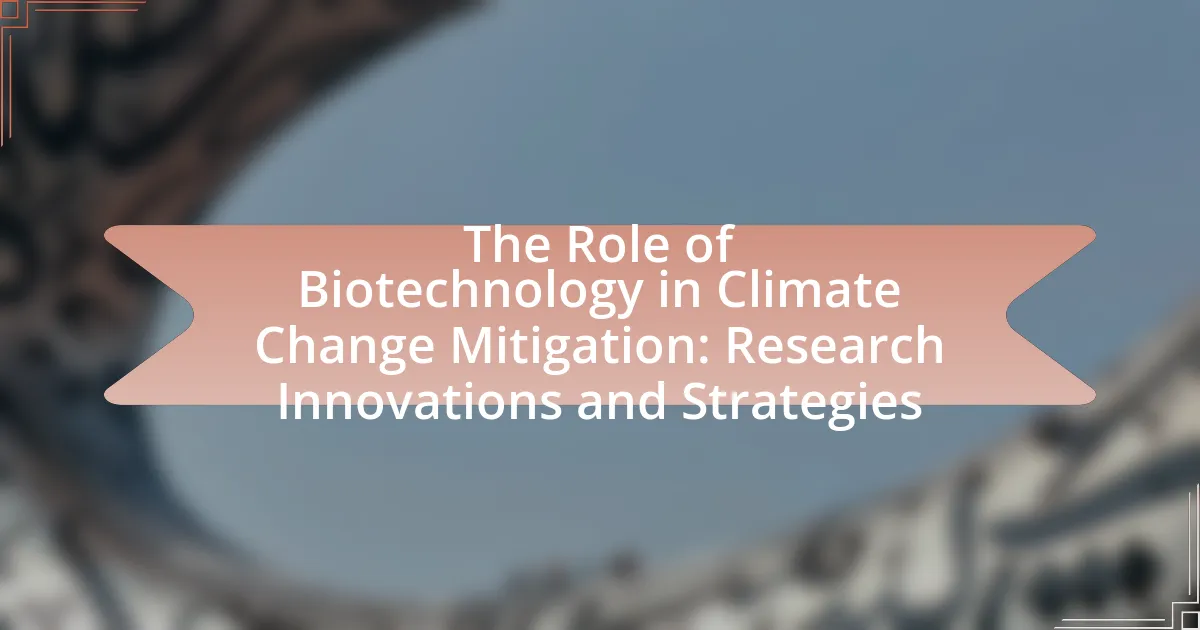The article focuses on the critical role of biotechnology in climate change mitigation, highlighting various research innovations and strategies. It discusses how biotechnology enhances agricultural productivity, develops biofuels, and improves carbon capture technologies, thereby reducing greenhouse gas emissions. Key topics include the development of genetically modified organisms (GMOs) for climate resilience, advancements in biofuel production, and biotechnological methods for carbon sequestration and soil health improvement. The article also addresses the challenges biotechnology faces in climate policies and emphasizes the importance of collaboration between public and private sectors to advance biotechnological solutions for sustainable practices.

What is the role of biotechnology in climate change mitigation?
Biotechnology plays a crucial role in climate change mitigation by enhancing agricultural productivity, developing biofuels, and improving carbon capture technologies. Through genetic engineering, biotechnology enables the creation of crop varieties that are more resilient to climate stressors, such as drought and pests, thereby increasing food security while reducing the need for chemical fertilizers and pesticides. Additionally, biotechnological advancements in the production of biofuels from biomass provide renewable energy sources that can replace fossil fuels, significantly lowering greenhouse gas emissions. Furthermore, biotechnological methods, such as the use of engineered microorganisms, can enhance carbon sequestration processes, capturing atmospheric CO2 and storing it in soil or other mediums. These applications demonstrate the potential of biotechnology to address the challenges posed by climate change effectively.
How does biotechnology contribute to reducing greenhouse gas emissions?
Biotechnology contributes to reducing greenhouse gas emissions by enabling the development of biofuels and bioproducts that replace fossil fuels. For instance, the use of genetically engineered microorganisms can enhance the efficiency of converting biomass into bioethanol, which emits significantly less carbon dioxide compared to traditional gasoline. Research indicates that biofuels derived from biomass can reduce greenhouse gas emissions by up to 86% compared to fossil fuels, as demonstrated in studies published by the National Renewable Energy Laboratory. Additionally, biotechnology facilitates carbon capture and storage through engineered plants that can absorb more carbon dioxide from the atmosphere, further mitigating climate change impacts.
What specific biotechnological processes are involved in carbon capture?
Biotechnological processes involved in carbon capture include microbial carbon capture, algal biofixation, and the use of genetically engineered plants. Microbial carbon capture utilizes specific bacteria that can metabolize carbon dioxide, converting it into biomass or other useful products. Algal biofixation employs microalgae, which absorb carbon dioxide during photosynthesis, effectively reducing atmospheric CO2 levels while producing oxygen and biomass. Genetically engineered plants have been developed to enhance their natural ability to sequester carbon, increasing their efficiency in capturing CO2 from the atmosphere. These processes are supported by research indicating that microbial systems can capture up to 90% of CO2 emissions in certain conditions, while algal systems can yield significant biomass for biofuels, demonstrating their potential in climate change mitigation strategies.
How do genetically modified organisms (GMOs) help in climate resilience?
Genetically modified organisms (GMOs) enhance climate resilience by developing crops that can withstand extreme weather conditions, such as drought, flooding, and temperature fluctuations. For instance, drought-resistant GMOs, like certain varieties of maize and soybeans, have been engineered to maintain yield stability under water-scarce conditions, which is crucial as climate change increases the frequency of droughts. Research indicates that these crops can reduce the need for irrigation by up to 30%, thereby conserving water resources. Additionally, GMOs can be designed to resist pests and diseases, reducing the reliance on chemical pesticides, which can have detrimental environmental impacts. This pest resistance contributes to sustainable agricultural practices, allowing farmers to maintain productivity even in challenging climates.
Why is biotechnology considered a key player in sustainable agriculture?
Biotechnology is considered a key player in sustainable agriculture because it enhances crop resilience, increases yield, and reduces the need for chemical inputs. By utilizing genetic engineering, biotechnology allows for the development of crops that can withstand environmental stresses such as drought, pests, and diseases, which is crucial for maintaining food security in the face of climate change. For instance, genetically modified organisms (GMOs) like Bt cotton and Bt corn have been shown to reduce pesticide use by up to 50%, leading to lower environmental impact and improved farmer profitability. Additionally, biotechnology contributes to sustainable practices by enabling the production of biofuels and biodegradable materials, further supporting the transition to a more sustainable agricultural system.
What are the advantages of using biotech crops in farming?
Biotech crops offer several advantages in farming, including increased yield, reduced pesticide use, and enhanced resistance to environmental stresses. These crops are engineered to be more productive, which can lead to higher food production levels; for instance, studies show that biotech crops can increase yields by 10-30% compared to conventional crops. Additionally, biotech crops often require fewer chemical pesticides, which can lower production costs and reduce environmental impact. Furthermore, many biotech crops are designed to withstand drought, pests, and diseases, making them more resilient in the face of climate change. This resilience is crucial as climate variability increases, ensuring food security and sustainable agricultural practices.
How does biotechnology enhance soil health and biodiversity?
Biotechnology enhances soil health and biodiversity by utilizing microbial inoculants and genetically modified organisms to improve nutrient cycling and promote beneficial soil microorganisms. For instance, the application of biofertilizers, which contain specific strains of bacteria or fungi, can increase soil fertility by fixing nitrogen and solubilizing phosphorus, thereby supporting plant growth and enhancing ecosystem diversity. Research has shown that the use of these biotechnological approaches can lead to a significant increase in microbial diversity and activity in the soil, which is crucial for maintaining healthy soil ecosystems. Studies indicate that soils treated with microbial inoculants exhibit improved structure, water retention, and resilience against pathogens, ultimately contributing to sustainable agricultural practices and biodiversity conservation.
What innovations in biotechnology are currently being researched for climate change mitigation?
Current innovations in biotechnology being researched for climate change mitigation include genetically engineered crops that enhance carbon sequestration, biofuels derived from algae, and microbial solutions for soil health. Genetically modified plants, such as those developed by researchers at the University of Illinois, are designed to increase photosynthetic efficiency, thereby capturing more carbon dioxide from the atmosphere. Algal biofuels, which can produce significantly more energy per acre than traditional crops, are being explored by institutions like the National Renewable Energy Laboratory, aiming to reduce reliance on fossil fuels. Additionally, the use of specific microbes to improve soil carbon storage is being investigated, as demonstrated in studies published in the journal Nature, which highlight the potential for these microorganisms to enhance soil fertility while sequestering carbon.
What are the latest advancements in biofuels and their impact on emissions?
Recent advancements in biofuels include the development of advanced biofuels such as cellulosic ethanol and algae-based fuels, which significantly reduce greenhouse gas emissions compared to traditional fossil fuels. For instance, cellulosic ethanol can lower emissions by up to 86% compared to gasoline, as reported by the U.S. Department of Energy. Additionally, innovations in genetic engineering have enhanced the efficiency of algae in producing biofuels, leading to a potential reduction in carbon emissions by capturing CO2 during growth. These advancements demonstrate a clear trend towards more sustainable biofuel production, contributing to climate change mitigation efforts.
How are synthetic biology and metabolic engineering shaping future solutions?
Synthetic biology and metabolic engineering are shaping future solutions by enabling the design and optimization of biological systems for sustainable production of biofuels, biochemicals, and food. These fields leverage genetic modifications to enhance the efficiency of metabolic pathways, allowing organisms to convert renewable resources into valuable products while minimizing waste and carbon emissions. For instance, research has demonstrated that engineered microorganisms can produce biofuels from carbon dioxide, effectively reducing greenhouse gas levels. Additionally, metabolic engineering has been applied to improve crop resilience and yield, which is crucial for food security in the face of climate change. These innovations are critical in developing sustainable practices that address environmental challenges and promote a circular economy.
How can biotechnology strategies be effectively implemented in climate policies?
Biotechnology strategies can be effectively implemented in climate policies by integrating biotechnological innovations into agricultural practices, waste management, and energy production. For instance, genetically modified crops that require fewer resources and are more resilient to climate stressors can enhance food security while reducing greenhouse gas emissions. Research from the National Academy of Sciences indicates that biotechnology can increase crop yields by up to 20% under adverse conditions, thereby supporting sustainable agricultural policies. Additionally, biotechnological methods for converting waste into biofuels can significantly lower carbon footprints, as demonstrated by studies showing that bioenergy can reduce emissions by 50% compared to fossil fuels. By aligning these biotechnological advancements with regulatory frameworks, policymakers can create effective climate strategies that leverage the benefits of biotechnology for environmental sustainability.
What challenges does biotechnology face in climate change mitigation efforts?
Biotechnology faces several challenges in climate change mitigation efforts, including regulatory hurdles, public acceptance, and technical limitations. Regulatory hurdles arise from complex approval processes that can delay the deployment of biotechnological solutions, such as genetically modified organisms designed for carbon sequestration. Public acceptance is often hindered by concerns over safety and ethical implications, which can lead to resistance against biotechnological innovations. Technical limitations include the need for advanced research to optimize bioprocesses and ensure that biotechnological solutions are economically viable and scalable. These challenges collectively impede the rapid integration of biotechnology into effective climate change strategies.

What are the specific strategies employed in biotechnological research for climate change?
Biotechnological research employs several specific strategies for climate change mitigation, including genetic engineering of crops for enhanced resilience, development of biofuels from biomass, and bioremediation techniques to restore contaminated environments. Genetic engineering allows for the creation of crop varieties that can withstand extreme weather conditions, thereby ensuring food security despite climate fluctuations. For instance, drought-resistant maize developed through genetic modification has shown increased yields in arid regions. The production of biofuels from agricultural waste and algae reduces reliance on fossil fuels, contributing to lower greenhouse gas emissions. Additionally, bioremediation utilizes microorganisms to degrade pollutants, effectively cleaning up oil spills and heavy metal contamination, which is crucial for maintaining ecosystem health in the face of climate change. These strategies are supported by research demonstrating their effectiveness in real-world applications, such as the successful deployment of genetically modified crops in various countries and the use of microbial solutions in environmental cleanup projects.
How do biotechnological innovations address energy needs sustainably?
Biotechnological innovations address energy needs sustainably by developing renewable biofuels and enhancing energy efficiency through microbial processes. For instance, the use of genetically engineered microorganisms can convert biomass into bioethanol, which serves as a cleaner alternative to fossil fuels. Research indicates that bioethanol production from agricultural waste can reduce greenhouse gas emissions by up to 86% compared to gasoline. Additionally, advancements in synthetic biology enable the optimization of algae for biofuel production, which can yield significantly higher energy outputs per acre than traditional crops. These innovations not only provide sustainable energy sources but also contribute to waste reduction and carbon sequestration, aligning with climate change mitigation strategies.
What role do algae play in renewable energy production?
Algae play a significant role in renewable energy production by serving as a source of biofuels, particularly biodiesel and bioethanol. These microorganisms can convert sunlight, carbon dioxide, and nutrients into biomass at a rapid rate, making them highly efficient for energy generation. Research indicates that certain algae species can produce up to 50% of their dry weight in lipids, which can be extracted and converted into biodiesel. Additionally, algae can utilize waste CO2 from industrial processes, thereby contributing to carbon capture and reducing greenhouse gas emissions. Studies have shown that algae-based biofuels can reduce lifecycle greenhouse gas emissions by up to 70% compared to fossil fuels, highlighting their potential in mitigating climate change.
How can waste-to-energy technologies be optimized through biotechnology?
Waste-to-energy technologies can be optimized through biotechnology by enhancing the efficiency of microbial processes that convert organic waste into energy. Specific biotechnological advancements, such as the use of genetically engineered microorganisms, can increase the rate of anaerobic digestion, leading to higher biogas yields. For instance, research has shown that certain strains of bacteria can degrade complex organic materials more effectively, resulting in a 20-30% increase in methane production compared to traditional methods. Additionally, biotechnological innovations like enzyme treatments can break down lignocellulosic biomass, making it more accessible for microbial digestion, thus improving overall energy recovery from waste.
What are the implications of biotechnology on water resource management?
Biotechnology significantly enhances water resource management by improving water quality and increasing efficiency in water usage. Techniques such as bioremediation utilize microorganisms to detoxify polluted water, effectively restoring ecosystems and making water safer for consumption and agriculture. Additionally, genetically engineered crops can be developed to require less water, thus conserving water resources in agricultural practices. For instance, drought-resistant varieties of crops have been shown to reduce water usage by up to 50%, as evidenced by research from the International Water Management Institute. These advancements not only optimize water use but also contribute to sustainable practices in the face of climate change challenges.
How can biotechnological solutions improve water efficiency in agriculture?
Biotechnological solutions can improve water efficiency in agriculture by developing drought-resistant crop varieties that require less water for growth. These genetically modified crops, such as drought-tolerant maize and rice, have been engineered to enhance their water retention capabilities and optimize their use of available moisture. Research indicates that these crops can yield up to 30% more produce under water-limited conditions compared to traditional varieties, significantly reducing the overall water demand in agricultural practices. Additionally, biotechnological advancements in soil microbiome management can enhance nutrient uptake and water retention in the soil, further contributing to improved water efficiency in farming systems.
What biotechnological methods are used for water purification and recycling?
Biotechnological methods used for water purification and recycling include bioremediation, constructed wetlands, and membrane bioreactors. Bioremediation employs microorganisms to degrade pollutants in water, effectively removing contaminants. Constructed wetlands utilize natural processes involving wetland vegetation, soil, and microbial communities to filter and treat wastewater. Membrane bioreactors combine biological treatment with membrane filtration, allowing for the separation of solids and pathogens from water, resulting in high-quality effluent. These methods are supported by studies demonstrating their effectiveness in reducing harmful substances and improving water quality, such as research published in the journal “Water Research,” which highlights the efficiency of these biotechnological approaches in various environmental contexts.
How does biotechnology support biodiversity conservation in the face of climate change?
Biotechnology supports biodiversity conservation in the face of climate change by enabling the development of resilient plant and animal species through genetic modification and biotechnological tools. These innovations allow for the enhancement of traits such as drought resistance, disease tolerance, and improved nutrient use efficiency, which are critical as climate conditions become more variable. For instance, genetically engineered crops like drought-tolerant maize have been shown to maintain yields under water-limited conditions, thereby supporting agricultural biodiversity and food security. Additionally, biotechnology facilitates the conservation of endangered species through techniques like cloning and assisted reproduction, which can help maintain genetic diversity and population viability in changing environments.
What are the biotechnological approaches to preserving endangered species?
Biotechnological approaches to preserving endangered species include genetic engineering, cloning, and assisted reproductive technologies. Genetic engineering allows for the modification of genes to enhance traits such as disease resistance or reproductive success, which can be critical for species survival. Cloning, exemplified by the successful cloning of the endangered black-footed ferret, enables the replication of individuals from a dwindling population, thereby increasing genetic diversity. Assisted reproductive technologies, such as in vitro fertilization and artificial insemination, facilitate breeding between individuals that may not otherwise mate in the wild, thus enhancing population growth. These methods have been validated through various conservation programs, demonstrating their effectiveness in increasing the numbers and genetic health of endangered species.
How can biotechnology aid in restoring ecosystems affected by climate change?
Biotechnology can aid in restoring ecosystems affected by climate change through the development of genetically modified organisms (GMOs) that enhance resilience to environmental stressors. For instance, scientists have engineered crops that require less water and can thrive in saline soils, which is crucial as climate change alters precipitation patterns and increases salinity in some regions. Research published in the journal “Nature Biotechnology” demonstrates that these crops can improve soil health and increase biodiversity by providing habitats for various organisms. Additionally, biotechnology facilitates the use of bioremediation techniques, where microorganisms are employed to detoxify polluted environments, thus restoring ecosystem functionality. Studies have shown that specific bacteria can break down pollutants in soil and water, effectively rehabilitating contaminated sites.

What are the future prospects of biotechnology in combating climate change?
The future prospects of biotechnology in combating climate change are promising, as advancements in genetic engineering, synthetic biology, and bioprocessing are expected to enhance carbon capture, improve crop resilience, and develop sustainable biofuels. For instance, genetically modified organisms (GMOs) can be engineered to absorb more carbon dioxide, while bioengineered crops can withstand extreme weather conditions, thus ensuring food security amid climate challenges. Additionally, the development of microbial systems for biofuel production can significantly reduce greenhouse gas emissions. Research indicates that biotechnological innovations could contribute to a reduction of up to 1.5 gigatons of CO2 emissions annually by 2030, highlighting the critical role of biotechnology in climate change mitigation strategies.
How can public and private sectors collaborate to advance biotechnological solutions?
Public and private sectors can collaborate to advance biotechnological solutions by establishing partnerships that leverage resources, expertise, and funding. For instance, public research institutions can provide foundational scientific knowledge and regulatory frameworks, while private companies can offer technological innovation and commercialization capabilities. A notable example is the collaboration between government agencies and biotech firms in developing genetically modified crops that are resistant to climate stressors, which has been shown to enhance food security and reduce agricultural emissions. Such partnerships can also facilitate knowledge transfer and accelerate the development of sustainable biotechnological practices, as evidenced by initiatives like the European Union’s Horizon 2020 program, which funds collaborative research projects aimed at addressing climate change through biotechnology.
What funding opportunities exist for biotechnological research in climate change?
Funding opportunities for biotechnological research in climate change include government grants, private sector investments, and international funding programs. For instance, the U.S. National Science Foundation offers grants specifically for research that addresses climate change through biotechnology, while the European Union’s Horizon Europe program allocates significant resources for innovative biotechnological solutions aimed at climate mitigation. Additionally, organizations like the Bill & Melinda Gates Foundation provide funding for projects that leverage biotechnology to combat climate-related challenges, emphasizing the importance of sustainable agricultural practices. These funding sources are crucial for advancing research and developing biotechnological innovations that can effectively address climate change impacts.
How can education and awareness enhance the adoption of biotechnological innovations?
Education and awareness can significantly enhance the adoption of biotechnological innovations by equipping individuals and communities with the knowledge needed to understand and appreciate the benefits of these technologies. When people are educated about the potential of biotechnology to address climate change, such as through genetically modified crops that require fewer resources or biofuels that reduce carbon emissions, they are more likely to support and adopt these innovations. Research indicates that informed communities are more receptive to biotechnological advancements; for instance, a study published in the journal “Nature Biotechnology” found that public understanding of biotechnology increased acceptance rates by up to 30%. This demonstrates that targeted educational initiatives can effectively bridge the gap between scientific advancements and public perception, ultimately leading to greater implementation of biotechnological solutions in climate change mitigation strategies.
What best practices should be followed in biotechnological research for climate change mitigation?
Best practices in biotechnological research for climate change mitigation include the development of sustainable bioprocesses, the use of genetically modified organisms (GMOs) for enhanced carbon sequestration, and the application of synthetic biology to create biofuels and bioplastics. Sustainable bioprocesses minimize waste and energy consumption, which is crucial for reducing greenhouse gas emissions. Research has shown that GMOs can significantly increase the efficiency of carbon capture in agricultural systems, with studies indicating that certain modified crops can sequester up to 30% more carbon than their non-modified counterparts. Additionally, synthetic biology enables the engineering of microorganisms to produce renewable energy sources, such as biofuels, which can replace fossil fuels and lower overall carbon footprints. These practices are supported by evidence from various studies, including those published in journals like Nature Biotechnology and Environmental Science & Technology, demonstrating their effectiveness in addressing climate change challenges.
How can individuals contribute to the advancement of biotechnology in climate action?
Individuals can contribute to the advancement of biotechnology in climate action by engaging in community-based projects that promote sustainable practices and support biotechnological innovations. For instance, participating in local initiatives that focus on bioengineering crops for increased resilience to climate change can enhance food security and reduce agricultural emissions. Research indicates that biotechnological advancements, such as genetically modified organisms (GMOs), can lead to crops that require fewer resources and produce higher yields, thereby mitigating climate impacts. Furthermore, individuals can advocate for policies that support biotechnological research and development, as evidenced by studies showing that public support for biotechnology can lead to increased funding and innovation in climate-related solutions.

